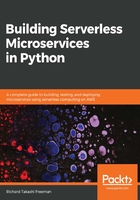
上QQ阅读APP看书,第一时间看更新
Serverless microservices pattern categories
On top of the software design patterns and principles we just discussed are the microservices patterns. From my experience, there are many microservices patterns that I recommended that are relevant for serverless microservices, as shown in the following diagram:

I created this diagram to summarize and illustrate the serverless microservices patterns we will be discussing in this book:
- Communication styles: How services communicate together and externally.
- Decomposition pattern: Creating a service that is loosely coupled by business capability or bounded context.
- Data management: Deals with local and shared data stores.
- Queries and messaging: Looks at events and messages that are sent between microservices, and how services are queried efficiently.
- Deployment: Where ideally we would like uniform and independent deployments, you also don't want developers to re-create a new pipeline for each bounded context or microservice.
- Observability and discovery: Being able to understand whether a service is functioning correctly, monitor and log activity allow you to drill down if there are issues. You also want to know and monitor what is currently running for cost and maintenance reasons, for example.
- Security: This is critical for compliance, data integrity, data availability, and potential financial damage. It's important to have different encryption, authentication, and authorization processes in place.
Next we will have a look at the communication styles and decomposition pattern first.